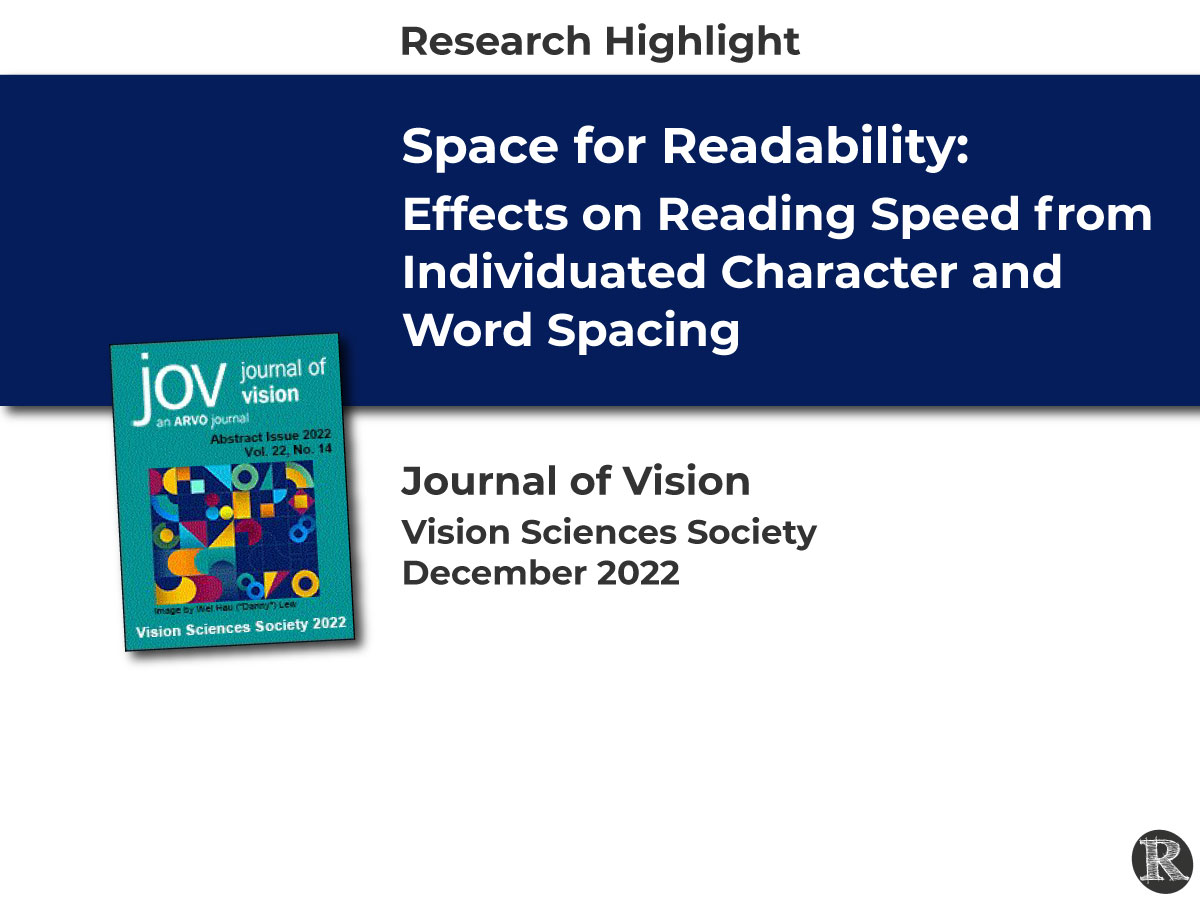Space for Readability: Effects on Reading Speed from Individuated Character and Word Spacing
Vision Sciences Society Annual Meeting
December 2022
The Vision Sciences Society has again highlighted readability work. A peer-reviewed abstract was presented at the VSS conference and published in the 2022 conference proceedings. The research studies the influence of character and word spacing on adult reading performance. The authors built on their previous work that demonstrated that individual typeface selection per reader could significantly increase reading speed while maintaining comprehension. The current research found that character spacing delivered strong effects on reading speed. Wallace et al. note that these findings join a growing body of work supporting readability interventions at the individual level.
Space for Readability: Effects on Reading Speed from Individuated Character and Word Spacing
Shaun WallaceJonathan DobresZoya BylinskiiBen Sawyer
Abstract
Our prior work shows that individual typeface selection per reader can significantly increase reading speed while maintaining comprehension. The present work extends that work to consider the influence of character and word spacing on adult reading performance in a large online study. In Study I, 102 remote Amazon Mechanical Turk participants (41 W, 61 M; ages 18–72, mean = 38.4), read passages with 11 different character spacings from -0.1em to 0.4em (increments of 0.05em). Each participant read all passages in a single font, randomly selected from a pool of six. In Study II, 113 participants (51 W, 60 M, 2 O; ages 21–72, mean = 35.2) followed similar study procedures to read passages with 8 different inter-word spacings (-0.2, -0.1, 0, 0.1, 0.2, 0.5, 1, 1.5 em). Across both studies, participants read 8th-grade level passages of 160–178 words, split across two screens. Consistent with similar remote studies, the second screen of each passage was read faster than the first (mean differences of 38 WPM and 29 WPM in Study I & II, respectively). Overall, character spacing had stronger effects on reading speed than word spacing, which may support the word-level theory of reading. However, the minimum negative and maximum positive spacings (character -0.1em and 0.4em; word -0.2em and 1.5em) showed significant speed, comprehension, and self-reported preference drop-offs. Faster readers suffered greater slowdowns at wide spacing (r = -0.38, p < .001). Character spacing significantly impacted reading speed on the second screen of reading, but not the first (X2(10) = 32.7, p < 0.001 and X2(10) = 9.7, N.S., respectively ). Both findings point to increased spacing hindering faster reading, complementing prior research showing wider spacing may help struggling readers. Together, these findings join a growing body of work supporting readability interventions at the individual level.
See the publication here: https://jov.arvojournals.org/article.aspx?articleid=2783976.
Citation
Wallace, S., Dobres, J., Bylinskii, Z., & Sawyer, B. (2022). Space for Readability: Effects on Reading Speed from Individuated Character and Word Spacing. Journal of Vision, 22(14), 3349. https://doi.org/10.1167/jov.22.14.3349




